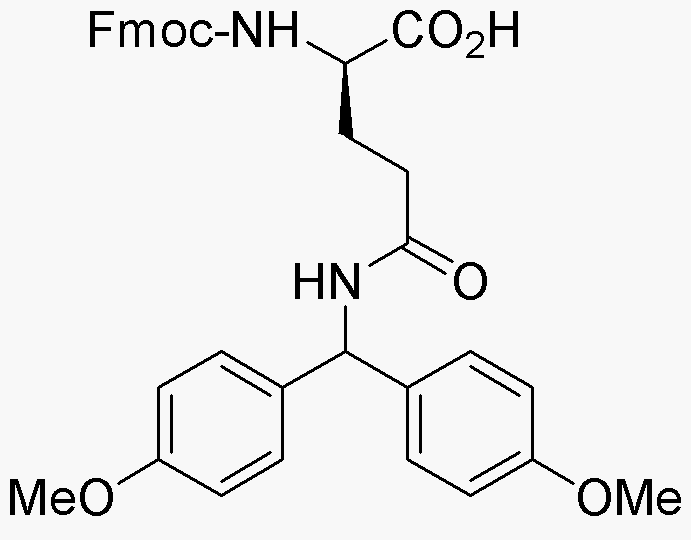Na-Fmoc-Nd-4,4'-dimethoxybenzhydryl-D-glutamine is widely utilized in research focused on:
- Peptide Synthesis: This compound serves as a protecting group in solid-phase peptide synthesis, allowing for the selective modification of amino acids without interfering with the overall peptide structure.
- Drug Development: Its unique structure aids in the design of peptide-based drugs, particularly in enhancing the stability and bioavailability of therapeutic peptides.
- Bioconjugation: The chemical is useful in bioconjugation processes, where it facilitates the attachment of peptides to other biomolecules, improving the efficacy of drug delivery systems.
- Research in Neuroscience: It can be employed in studies related to neuropeptides, helping researchers understand their roles in neurological functions and potential therapeutic applications.
- Analytical Chemistry: This compound is valuable in analytical methods for characterizing peptide structures, providing insights into their properties and interactions.
General Information
Properties
Safety and Regulations
Applications
Na-Fmoc-Nd-4,4'-dimethoxybenzhydryl-D-glutamine is widely utilized in research focused on:
- Peptide Synthesis: This compound serves as a protecting group in solid-phase peptide synthesis, allowing for the selective modification of amino acids without interfering with the overall peptide structure.
- Drug Development: Its unique structure aids in the design of peptide-based drugs, particularly in enhancing the stability and bioavailability of therapeutic peptides.
- Bioconjugation: The chemical is useful in bioconjugation processes, where it facilitates the attachment of peptides to other biomolecules, improving the efficacy of drug delivery systems.
- Research in Neuroscience: It can be employed in studies related to neuropeptides, helping researchers understand their roles in neurological functions and potential therapeutic applications.
- Analytical Chemistry: This compound is valuable in analytical methods for characterizing peptide structures, providing insights into their properties and interactions.
Documents
Safety Data Sheets (SDS)
The SDS provides comprehensive safety information on handling, storage, and disposal of the product.
Product Specification (PS)
The PS provides a comprehensive breakdown of the product’s properties, including chemical composition, physical state, purity, and storage requirements. It also details acceptable quality ranges and the product's intended applications.
Certificates of Analysis (COA)
Search for Certificates of Analysis (COA) by entering the products Lot Number. Lot and Batch Numbers can be found on a product’s label following the words ‘Lot’ or ‘Batch’.
*Catalog Number
*Lot Number
Certificates Of Origin (COO)
This COO confirms the country where the product was manufactured, and also details the materials and components used in it and whether it is derived from natural, synthetic, or other specific sources. This certificate may be required for customs, trade, and regulatory compliance.
*Catalog Number
*Lot Number
Safety Data Sheets (SDS)
The SDS provides comprehensive safety information on handling, storage, and disposal of the product.
DownloadProduct Specification (PS)
The PS provides a comprehensive breakdown of the product’s properties, including chemical composition, physical state, purity, and storage requirements. It also details acceptable quality ranges and the product's intended applications.
DownloadCertificates of Analysis (COA)
Search for Certificates of Analysis (COA) by entering the products Lot Number. Lot and Batch Numbers can be found on a product’s label following the words ‘Lot’ or ‘Batch’.
*Catalog Number
*Lot Number
Certificates Of Origin (COO)
This COO confirms the country where the product was manufactured, and also details the materials and components used in it and whether it is derived from natural, synthetic, or other specific sources. This certificate may be required for customs, trade, and regulatory compliance.


